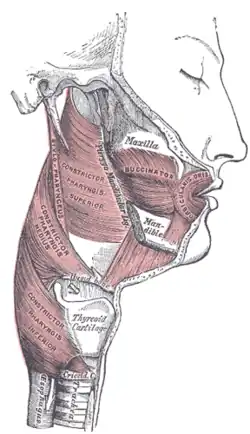Pterygomandibular raphe
| Pterygomandibular raphe | |
|---|---|
 | |
| Details | |
| Part of | buccopharyngeal fascia |
| Origin | pterygoid hamulus of the medial pterygoid plate |
| Insertion | mylohyoid line of the mandible |
| Identifiers | |
| Latin | raphe pterygomandibularis |
| TA98 | A05.3.01.102 |
| TA2 | 2178 |
| FMA | 55618 |
| Anatomical terminology | |
The pterygomandibular raphe (pterygomandibular ligament) is a ligamentous band of the buccopharyngeal fascia. It is attached superiorly to the pterygoid hamulus of the medial pterygoid plate, and inferiorly to the posterior end of the mylohyoid line of the mandible. It connects the buccinator muscle in front to the superior pharyngeal constrictor muscle behind. It resists mandibular realignment.
Structure

The pterygomandibular raphe is a ligament that forms from the buccopharyngeal fascia.[1] It is a paired structure, with one on each side of the mouth. Superiorly, it is attached to the pterygoid hamulus of the medial pterygoid plate of the sphenoid bone.[1] Inferiorly, it is attached to the posterior end of the mylohyoid line of the mandible.[1]
- Its medial surface is covered by the mucous membrane of the mouth.[1]
- Its lateral surface is separated from the ramus of the mandible by a quantity of adipose tissue.
- Its posterior border gives attachment to the superior pharyngeal constrictor muscle.[1]
- Its anterior border attaches to the posterior edge of the buccinator muscle.[1]
Variation
In foetuses, the pterygomandibular raphe is always very prominent.[2] However, in adults, it may become less distinctive.[2] It is very large and distinctive in around 36% adults.[2] It is fairly small, and only an upper triangular portion visible, in around 36% of adults.[2] It is not visible in around 28%, making the superior pharyngeal constrictor muscle and the buccinator muscle continuous.[2] This may vary by ethnic group.[2]
Function
The pterygomandibular raphe is the common meeting point of the superior pharyngeal constrictor muscle and the buccinator muscle. It holds them together, forming part of the mouth.[1]
Clinical significance
When the mandible is splinted for gradual realignment (such as to treat sleep apnea), the pterygomandibular ligament slightly resists the realignment.[3]
History
The pterygomandibular ligament was first noted in 1784.[1]
See also
References
![]() This article incorporates text in the public domain from page 384 of the 20th edition of Gray's Anatomy (1918)
This article incorporates text in the public domain from page 384 of the 20th edition of Gray's Anatomy (1918)
- 1 2 3 4 5 6 7 8 Rao, D.; Sandhu, S.J.S.; Ormsby, C.; Natter, P.; Haymes, D.; Cohen, I.; Jenson, M. (2017-04-01). "Review of the Pterygomandibular Raphe". Neurographics. 7 (2): 121–125. doi:10.3174/ng.2170196.
- 1 2 3 4 5 6 Shimada, Kazuyuki; Gasser, Raymond F. (1989). "Morphology of the pterygomandibular raphe in human fetuses and adults". The Anatomical Record. 224 (1): 117–122. doi:10.1002/ar.1092240115. ISSN 1097-0185.
- ↑ Brown, Elizabeth C; Jugé, Lauriane; Knapman, Fiona L; Burke, Peter G R; Ngiam, Joachim; Sutherland, Kate; Butler, Jane E; Eckert, Danny J; Cistulli, Peter A; Bilston, Lynne E (2021-04-01). "Mandibular advancement splint response is associated with the pterygomandibular raphe". Sleep. 44 (4). doi:10.1093/sleep/zsaa222. ISSN 0161-8105.
External links
- "Anatomy diagram: 05287.011-1". Roche Lexicon - illustrated navigator. Elsevier. Archived from the original on 2013-04-22.